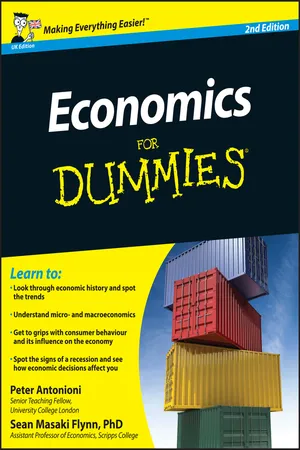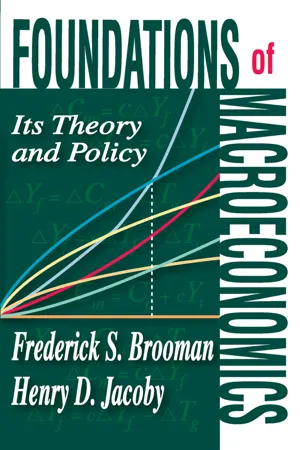Economics
What Causes Aggregate Supply to Shift
Aggregate supply can shift due to changes in production costs, such as wages and raw material prices, which impact firms' willingness to produce goods and services. Additionally, technological advancements and changes in the availability of resources can also influence aggregate supply by affecting the efficiency and capacity of production.
Written by Perlego with AI-assistance
Related key terms
Related key terms
1 of 4
Related key terms
1 of 3
9 Key excerpts on "What Causes Aggregate Supply to Shift"
- No longer available |Learn more
Contemporary Economics
An Applications Approach
- Robert Carbaugh(Author)
- 2016(Publication Date)
- Routledge(Publisher)
- The model of aggregate demand and aggregate supply can be used to show how output and prices are determined in the short run. An economy is in equilibrium when aggregate demand equals aggregate supply.
- The aggregate demand curve shows the total amount of real output that buyers will purchase at alternative price levels during a given year. Movements along an aggregate demand curve are caused by changes in the price level of the economy. Shifts in the aggregate demand curve are caused by changes in non-price factors that affect household consumption expenditures, business investment, government expenditures, and net exports of goods and services.
- According to the multiplier effect, a change in any one of the components of aggregate demand (consumption, investment, government spending, or net exports) will have a magnified impact on national output and income. The size of the multiplier depends on the spending and saving habits of consumers and businesses.
- The aggregate supply curve shows the relationship between the level of prices and amount of real output that will be produced by the economy in a given year. The aggregate supply curve is horizontal when the economy is in deep recession or depression, upward-sloping when the economy approaches full employment, and vertical when the economy achieves full employment. Changes in factors such as resource prices, resource availability, and the level of technology will cause the aggregate supply curve to shift.
- The model of aggregate demand and aggregate supply can be applied to the problems of recession and inflation. According to this model, decreases in aggregate demand or aggregate supply can push the economy into recession; inflation may be the result of increases in aggregate demand or decreases in aggregate supply. An economy experiences “stagflation” when there is both recession and inflation.
- eBook - ePub
The American Economy: A Student Study Guide
A Student Study Guide
- Wade L. Thomas, Robert B. Carson(Authors)
- 2015(Publication Date)
- Routledge(Publisher)
The cyclical behavior of the economy has long attracted economists’ attention and a variety of explanations have been put forward to explain the expansion and contraction of the economy. Indeed, the business cycle remains at the center of macroeconomic theory and policy-making objectives. 4. The principal tool of the modern-day macroeconomist in efforts to study and explain aggregate economic behavior is aggregate demand and aggregate supply analysis. By viewing aggregate output of the economy in terms of spending for goods and services (aggregate demand) and the output values of actual production (aggregate supply), the relationships that exist between price levels and levels of real output can be discerned. Shifts in aggregate demand and aggregate supply necessarily affect price level-output combinations - eBook - ePub
Economics
The Definitive Encyclopedia from Theory to Practice [4 volumes]
- David A. Dieterle(Author)
- 2017(Publication Date)
- Greenwood(Publisher)
A AGGREGATE DEMAND AND AGGREGATE SUPPLYAggregate demand and aggregate supply are two of the primary concepts in macroeconomics. Aggregate means total, and demand is the desire and ability to purchase goods and services. Supply refers to the desire and ability of producers to provide goods and services. Aggregate demand is the total amount of goods and services demanded in an economy during a given time period, while aggregate supply is the total amount of goods and services provided. Aggregate demand is composed of all consumer spending, investment spending, government spending, and net exports (exports–imports)—the components of gross domestic product (GDP). Aggregate supply is composed of all income, in the forms of wages, rents, profits, and interest earned.The British economist John Maynard Keynes (1883–1946) is credited with creating the concepts of aggregate demand and aggregate supply. He used these concepts in the 1930s to explain how governments can recover from recessions by increasing government spending to impact aggregate demand, which in turn would increase aggregate supply. Keynes did the lion’s share of his writing and economic thought from 1920 to 1940. Prior to Keynes, market explanations centered on classical economics, popularized by the writings of Adam Smith (1723–1790). Smith emphasized the market concept of laissez faire, which is the minimal use of government actions to control economic activity.Aggregate demand and aggregate supply are graphed on the aggregate demand and aggregate supply graph with the y-axis being the general price level, or CPI, and the x-axis being real GDP. The aggregate demand curve is downward-sloping to the right while the aggregate supply curve is upward-sloping.Aggregate DemandMost economists support the downward-sloping aggregate demand (AD) curve for three primary reasons: the wealth effect, the interest rate effect, and the exchange rate effect. All three of the explanations for the downward-sloping AD curve center around lower prices, which induce greater quantity demanded and the downward slope of the AD curve. When the price level falls, wages do not change immediately, which makes consumers feel wealthier so they purchase more goods and services than before. When interest rates fall, consumer spending on durable goods such as homes and cars and business investments on capital goods will increase. When the domestic exchange rate falls, domestic exports become relatively cheaper to foreign consumers and foreign sales will increase. - eBook - ePub
Economics for Investment Decision Makers
Micro, Macro, and International Economics
- Christopher D. Piros, Jerald E. Pinto(Authors)
- 2013(Publication Date)
- Wiley(Publisher)
- In the long run, all prices are assumed to be flexible. The long-run aggregate supply curve is vertical because input costs adjust to changes in output prices, leaving the optimal level of output unchanged. The position of the curve is determined by the economy’s level of potential GDP.
- The level of potential output, also called the full employment or natural level of output, is unobservable and difficult to measure precisely. This concept represents an efficient and unconstrained level of production at which companies have enough spare capacity to avoid bottlenecks and there is a balance between the pool of unemployed workers and the pool of job openings.
- The long-run aggregate supply curve will shift because of changes in labor supply, supply of physical and human capital, and productivity/technology.
- The short-run supply curve will shift because of changes in potential GDP, nominal wages, input prices, expectations about future prices, business taxes and subsidies, and the exchange rate.
- The business cycle and short-term fluctuations in GDP are caused by shifts in aggregate demand and aggregate supply.
- When the level of GDP in the economy is below potential GDP, such a recessionary situation exerts downward pressure on the aggregate price level.
- When the level of GDP is above potential GDP, such an overheated situation puts upward pressure on the aggregate price level.
- Stagflation, a combination of high inflation and weak economic growth, is caused by a decline in short-run aggregate supply.
- The sustainable rate of economic growth is measured by the rate of increase in the economy’s productive capacity or potential GDP.
- Growth in real GDP measures how rapidly the total economy is expanding. Per capita GDP, defined as real GDP divided by population, reflects the standard of living in a country. Real GDP growth rates and levels of per capita GDP vary widely among countries.
- eBook - ePub
- Harlan M. Smith(Author)
- 2016(Publication Date)
- Routledge(Publisher)
Finally, the reconceived aggregate supply curve just discussed is a one-directional curve. The upswing of a business cycle may be described by the curve, but when a downswing follows, the economy does not ride back down the curve, with prices falling but no output drop at first. Rather, output tends to drop first, for reasons explained by various institutional semi-rigidities in prices and wages, and only after prolonged unemployment and recession are prices likely to drop much. The result is a sort of spiral in wages and prices over cycles, and an upward trend in the price level over time. Successive cycles move the Phase 3 line slowly to the right, representing increases in potential output arising from growth in productivity and in the volume of employed resources (capital and labor).Reviewing now the analysis of the shift from the micro to the macro level in the treatment of demand and supply, the analysis led to dropping the aggregate demand curve, substituting the total volume of spending, and reinterpreting the aggregate supply curve. At the macro level, quantities supplied and quantities demanded are never even semi-independent but each is the major determinant of the other, and neither can be treated as an independent function of price. Changes in aggregate quantity supplied are ordinarily based upon expected changes in the aggregate quantity demanded, but innovation or other changes on the supply side can occur independently and produce changes in aggregate demand. We also have analyzed the things that determine some degree of accompanying change in the price level.The textbooks discuss how a change in the aggregate demand or supply curve produces a new equilibrium. But this should be only a stepping-stone to discussing the somewhat irregular fluctuations in output that we often lump under the heading of business cycles. Economic historians can tell us that each “cycle” is somewhat unique, but economists ignore their uniqueness, however important the differences may sometimes be, to focus upon common features. Clearly changes in the rate of real investment are the main driving force in these cycles. Explanation of its changes is not simple. But students should learn that a cycle can be generated just by the combination of the multiplier and acceleration principles. First let us look at the downswing of a cycle. - eBook - ePub
- Peter Antonioni, Sean Masaki Flynn(Authors)
- 2010(Publication Date)
- For Dummies(Publisher)
for long. At price level P Low , people want to buy Y Highworth of output. But that’s more than firms can produce at full employment. The only way to produce that much output is if employees work longer than the standard working week. The only way to get them to do so is to pay them more, and the only way to give them higher wages is for firms to raise prices. So with demand exceeding supply, prices are raised until they reachP * , at which price level the quantity demanded by consumers is exactly equal to the full-employment output level, Y * .As you can see, if prices have enough time to adjust, the economy always returns to producing at output level Y * . Because we’re calling the time required for prices to adjust the long run , it makes sense to call the vertical line above Y * the long-run aggregate supply curveA shock to the system: Adjusting to a shift in aggregate demand, because it shows how much output the economy will supply after prices have had enough time to adjust to equalise the supply and demand for goods and services. (For much more about supply and demand, see Chapter 8.)The previous section shows what happens if the prices of goods and services are, on the whole, too high or too low: they eventually adjust to the equilibrium price level (P * ) , and so the economy can get back to producing at the full-employment output level (Y * ). But what causes the prices to be too high or too low in the first place? The usual cause is a shock to aggregate demand – the total amount of goods and services that people are willing to buy.First, visualise what a shock to aggregate demand looks like: Figure 6-3 shows the aggregate demand curve shifting to the left from AD o to AD 1 . A leftward shift of aggregate demand is called a negative demand shock , and it may be caused, for example, by a decline in confidence in the economy that makes people want to save more and consume less. (A rightward shift of - eBook - ePub
Foundations of Macroeconomics
Its Theory and Policy
- Frederick S. Brooman(Author)
- 2017(Publication Date)
- Routledge(Publisher)
3. Variations in Price and Money WagesThe intersection of the aggregate supply and demand curves indicates both the equilibrium level of physical output and (given the constant money wage w̄) the equilibrium level of prices. If an autonomous change in “real” demand occurs, it will shift the aggregate demand curve to intersect the aggregate supply curve at a new equilibrium position. Thus, in Figure 10.3 , an increase in real investment will raise the aggregate demand curve from d1 (Q,p) to d2 (Q,p); equilibrium moves from E1 to E2 , output rises from Q1 to Q2 , and prices increase from the level indicated by the slope of p1 to that indicated by the slope of p2 . As long as firms continue to offer their output at its supply price (i.e., w̄) MPL), their response to the increase in demand will be to attempt to produce more commodities and to raise their selling prices only when the expansion of output and employment reduces the marginal product of labor, making price increases necessary to meet the rising value of ‘w̄/MPL. The transition from the old equilibrium at E1 to the new one at E2 will then take the form of an upward movement along the aggregate supply curve.However, firms may react in a different way. Faced with excess demand equal to E1 T in money terms, they may begin by raising prices to the level that buyers seem willing to pay – namely, the price level p3 . The price rise will immediately create an incentive for firms to increase production, since the excess of price over marginal labor cost w̄/MPL shows that they will add to their profits if they hire more labor and expand output; but before the expansion can get under way, the situation may be made more complicated by the effects of the price increase on aggregate demand. If the “real” relationship between income and demand remains unchanged, the amount of money that buyers wish to spend will rise in the same proportion as the price level, and in money terms the excess demand will be still larger than before.11 On the other hand, the price increase will have set the redistribution effect to work, because with money wages constant, real wages have fallen; at the original level of output Q1 , both total real wages and the “wage share” in income will be reduced in proportion to the rise in prices, causing a fall in real consumption to the extent that the wage earners’ MPC exceeds the MPC of profit recipients.12 - eBook - ePub
A Primer on Macroeconomics
Policies and Perspectives
- Thomas M. Beveridge(Author)
- 2018(Publication Date)
- Business Expert Press(Publisher)
CHAPTER 5 Aggregate Demand and Aggregate Supply By the end of this chapter, you will be able to:- Define aggregate demand and explain why the aggregate demand curve has a negative slope.
- Identify seven factors that can shift the position of the aggregate demand curve.
- Describe how aggregate demand is affected by fiscal and monetary policy actions.
- Distinguish between the short run and the long run.
- Explain the slope and location of the long-run aggregate supply curve.
- Explain the slope of the short-run aggregate supply curve and its relationship to the long-run aggregate supply curve.
- Identify the factors that shift the long-run and short-run aggregate supply curves.
- Explain how the economy achieves short-run equilibrium.
- Outline the operation of the self-correcting mechanism and its relevance to the achievement of long-run equilibrium.
- Distinguish the beliefs of the Classical economists from those of the Keynesians.
- Describe the role of the expenditure multiplier in the macroeconomy.
In Volume I, we identified the major elements and models that economists use to study our world of choices—the chief being, of course, demand and supply analysis. In this volume, we will dig deeper into these principles and use them to discover how policies and perspectives influence our economic well-being.In this chapter you may gain some insights - eBook - ePub
- David G. Tuerck(Author)
- 2021(Publication Date)
- Business Expert Press(Publisher)
1 . Prices fall from OB to OC. Even though aggregate demand has fallen, the reluctance of employers to cut wages in tandem with falling prices causes workers to offer more of their services and causes output to rise temporarily from OA to OE.Figure 11.6 Decrease in AD and decrease in SRAS with employer myopiaOnce employers realize that their reluctance to cut wages is unwarranted, they will cut wages in tandem with the fall in prices. Short-run aggregate supply will shift from SRAS1 to SRAS2 , prices will rise to OD, and output will return to its long-run equilibrium level as the economy adjusts to point Z.In this section and the one before, the general presumption in favor of relative wage “stickiness” was brought about by worker or employer myopia. In both the sections, wages lag behind prices until either workers or employers are able to see their error and make the needed correction. The logic here flows from the fact that when people find themselves holding more (or less) money than they wish to hold, they will collectively attempt to bring their actual money holdings in line with their desired money holdings, the effect of which is to cause aggregate demand to rise (or fall).Whether that leads to a temporary rise (or fall) in output depends on the ability of workers and employers to see what is afoot, which is to say that there is an economywide rise—or fall—in aggregate demand. Workers and employers must then diagnose what the change in demand means to their particular part of the economy. It is the possible lag between when workers and employers feel the impact of the change in aggregate demand and when they determine that the impact was, in fact, attributable to a change in aggregate demand that causes the maladjustment.
Index pages curate the most relevant extracts from our library of academic textbooks. They’ve been created using an in-house natural language model (NLM), each adding context and meaning to key research topics.
Explore more topic indexes
Explore more topic indexes
1 of 6
Explore more topic indexes
1 of 4








